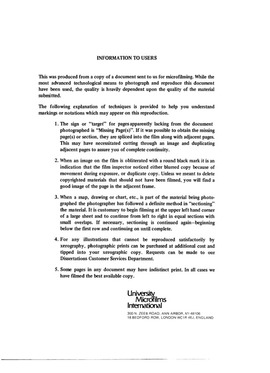| dc.contributor.author | Leuck, Beth Emily, | en_US |
| dc.date.accessioned | 2013-08-16T12:28:05Z | |
| dc.date.available | 2013-08-16T12:28:05Z | |
| dc.date.issued | 1980 | en_US |
| dc.identifier.uri | https://hdl.handle.net/11244/4748 | |
| dc.description.abstract | Nepotistic behavior was never observed among parthenogenetic whiptails for several possible reasons. First, it appears that members of parthenogenetic whiptail populations are not genetically identical due to independent origins of clones, mutation and/or recombination. Second, because parthenogenetic whiptail species are hybrids between two or three bisexual species, they may contain gene combinations that result in competitive rather than cooperative behavior. Third, whiptail species do not defend resources, so opportunities for sharing or sacrificing resources are low. | en_US |
| dc.description.abstract | Aggressive interactions (supplanting, chasing and biting), competition over food items and fighting were less common in parthenogens than in bisexuals, indicating that the genetic relatedness of the parthenogens may affect behavioral differences. Organization of groups into linear dominance hierarchies and the strength of these hierarchies were more dependent on the presence of males in the bisexual groups. Therefore, two factors potentially influencing differences in social behavior between parthenogenetic and bisexual whiptail lizards are the high degree of relatedness of the parthenogens and the absence of males in unisexual populations. | en_US |
| dc.description.abstract | Animals reproducing asexually, such as parthenogenetic animals, may share 100% of their genes with other population members. Because of this high genetic relatedness, kin selection may act on the behavior of asexual animals. I studied two parthenogenetic and one bisexual species of whiptail lizards (Cnemidophorus) to find if parthenogens acted more nepotistically toward each other than bisexuals as predicted by kin selection theory. Groups of five conspecific lizards of C. tesselatus and C. neomexicanus (parthenogenetic) and C. sexlineatus (bisexual) were observed in identical outdoor enclosures. | en_US |
| dc.description.abstract | Genetic unity among conspecific parthenogens may also lead to cooperative space use by parthenogenetic lizards, while bisexual whiptails, which are less related to each other, may compete for limited spatial features. Groups of five conspecific parthenogens used a significantly greater number of sites for digging burrows in enclosures than did the more site-specific bisexuals. Neither type of whiptail lizard maintained territories nor defended objects to the exclusion of conspecifics, and both shared objects under which they burrowed (burrow sites). Parthenogens shared actual burrows (nine occurrences), but only one case of burrow sharing among bisexuals was observed. As the number of lizards above ground in each enclosure increased, aggression levels increased significantly in C. sexlineatus groups containing males, indicating males may control the aggressive characteristics of a group. Activity above ground in all whiptail lizard groups peaked in late morning to early afternoon, but no trends correlating activity with daily high temperatures were apparent. Therefore, space use and activity may have been affected by three factors: (1) differences in genetic relatedness of parthenogens and bisexuals, (2) presence or absence of males in groups and (3) species-specific differences. | en_US |
| dc.format.extent | vi, 104 leaves : | en_US |
| dc.subject | Biology, Zoology. | en_US |
| dc.title | Life with and without sex : | en_US |
| dc.type | Thesis | en_US |
| dc.thesis.degree | Ph.D. | en_US |
| dc.thesis.degreeDiscipline | Department of Biology | en_US |
| dc.note | Source: Dissertation Abstracts International, Volume: 41-05, Section: B, page: 1677. | en_US |
| ou.identifier | (UMI)AAI8024416 | en_US |
| ou.group | College of Arts and Sciences::Department of Biology | |
